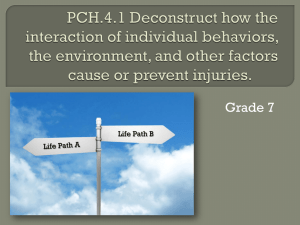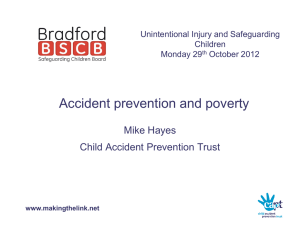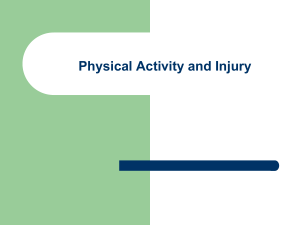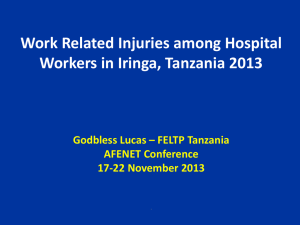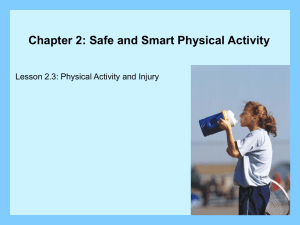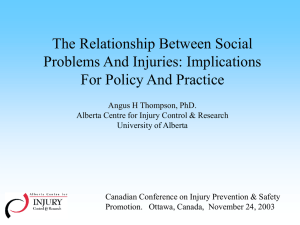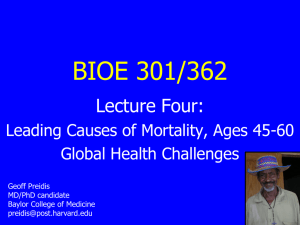NICE Guidance in Practice (PowerPoint)
advertisement
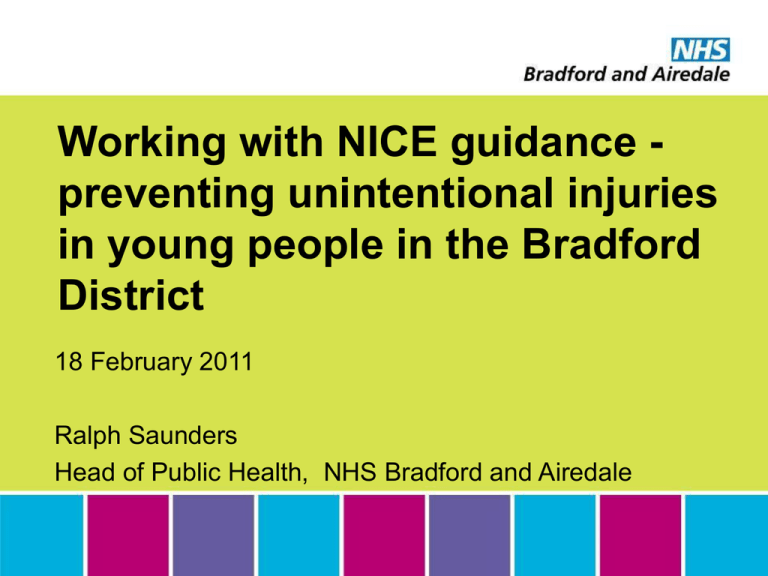
Working with NICE guidance preventing unintentional injuries in young people in the Bradford District 18 February 2011 Ralph Saunders Head of Public Health, NHS Bradford and Airedale What is NICE? The National Institute for Health and Clinical Excellence (NICE) is the independent organisation responsible for providing national guidance on the promotion of good health and the prevention and treatment of ill health. What do NICE do? Advice on new and existing treatments Clinical guidelines, QOF and quality standards NICE and NHS Evidence Evidence – guidance – shared learning Health promotion and disease prevention Comprehensive evidence service Core principles of all NICE guidance • Comprehensive evidence base • Expert input • Patient and carer involvement • Independent advisory committees • Genuine consultation • Regular review • Open and transparent process. NICE guidance can help… • public, patients and carers • professionals • organisations Public Health Outcomes Framework (in consultation) Reference Outcome Indicator D1.2 Systems in place to ensure effective and adequate surveillance of health protection risks and hazards. Rationale/Description PH Outcomes Framework D2.15 Killed and seriously injured casualties on England’s roads Incidents and collisions on the roads are a significant cause of death and injuries; disproportionately so among young age groups and in disadvantaged areas. They have a large effect on the resources of health and rescue services. D3.6 Hospital admissions caused by unintentional and deliberate injuries to 5-18s Injuries are the leading cause of death in children and disproportionately affect children from lower socioeconomic groups. Reference D4.1 D5.1 Outcome Indicator Rationale/Description PH Outcomes Framework Hospital admissions caused by unintentional and deliberate injuries (1-5 years) Injuries are a leading cause of death in children and disproportionately affect children from lower socioeconomic groups. Infant mortality Infant mortality is a widely used indicator of the overall health of a population. It reflects a broad range of determinants including upstream determinants such as economic development, general living conditions and social and environmental factors. Preventing unintentional injuries among under-15s • Strategies to prevent unintentional injuries among under-15s • Preventing unintentional injuries among under-15s in the home • Preventing unintentional injuries among under-15s: road design • The phrase ‘unintentional injuries’ (rather than ‘accidents’ ) is used as most injuries and their causes are predictable and preventable • Unintentional injury is a leading cause of death and injury among children and young people • Children and young people from lower socioeconomic groups are more likely to be affected by unintentional injuries Recommendations • Planning and co-ordination • Home safety • Outdoor play and leisure • Road safety Planning and co-ordination • Ensure local plans commit to preventing unintentional injuries among under-15s, with a focus on those who are most at risk • Ensure there is a trained child and young person injury prevention coordinator in each locality • Identify and respond to attendances at emergency units and minor injury units Home safety There is a separate piece of guidance relating directly to home safety (PH 30). This includes the following recommendations: • Include home safety assessments and education in local plans • Prioritise households at greatest risk • Establish multi-sector partnerships or support existing ones to collect information carry out assessments and promote home safety • Offer home safety assessments and supply and install equipment Home safety: households at greatest risk • Identify and prioritise households most at risk and offer home assessments • Ensure the assessment, supply and installation of equipment is tailored to need and includes the provision of information and advice • Provide practitioners who visit children and young people at home with mechanisms for sharing information • Ensure practitioners adhere to good practice on maintaining the confidentiality and security of personal information Outdoor play and leisure • Ensure a prevention policy is in place which balances fun, physical activity and learning • Provide education, information and advice on the use of equipment to manage risk • Encourage cycle training and promote the use of correctly fitted and fastened cycle helmets • Conduct local injury prevention campaigns for all events where fireworks may be used Road safety: partnerships • Maintain road safety partnerships to help plan, coordinate and manage road safety activities • Ensure a senior public health person leads – and is responsible for – health sector involvement • Ensure local child safety reviews are carried out at least every 3 years • Ensure consistency within local child safety policies, local plans and strategies Road safety: Speed reduction • Introduce engineering measures to reduce speed in streets that are primarily residential or where pedestrian and cyclist movements are high • Consider changing speed limits and introducing appropriate engineering measures to: - reduce speeds on rural roads - provide safer routes commonly used by children and young people Implementation - practical support • How to guide • Specific implementation tools • Forward planner • Costing reports and templates Gillian Mathews • Educational tools • Shared learning database Annie Coppel Deborah Bent Chris Connell Jane Moore • Implementation consultants Steve Sparks Stephen Judge Local Implications for partnerships including health • How the recommendations will be taken forward locally involving our local partnerships • The mechanisms for enabling frontline health staff to implement the recommendations • How the current work in localities will continue and grow in relation to the prevention of unintentional injuries to children and young people aged 15 and under
